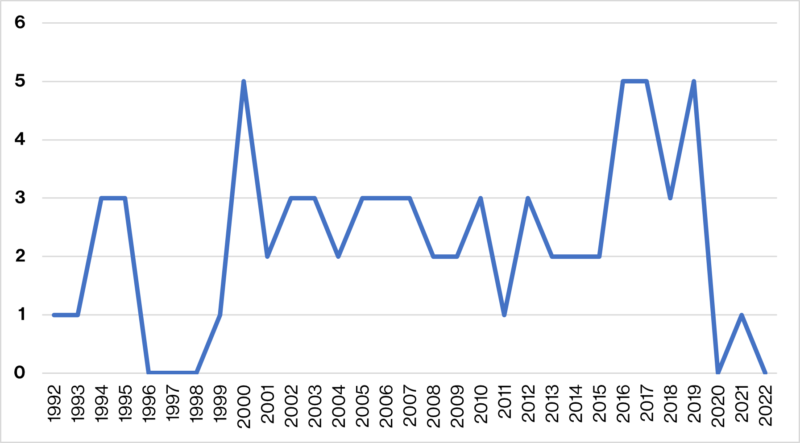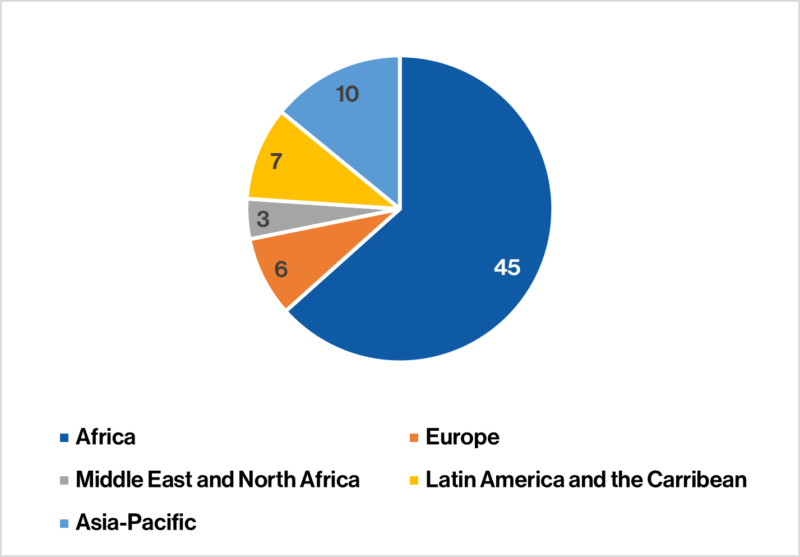In Hindsight: The UN Security Council Returns to the Field
In March, the Security Council is expected to conduct its 70th visiting mission since 1992. This trip to the Democratic Republic of the Congo (DRC) will be only the second Council visiting mission since October 2019, and the first since it travelled to Mali and Niger in October 2021. In the few years preceding the outbreak of COVID-19, the Council undertook multiple such missions every year: five trips each in 2016, 2017 and 2019, with three in 2018.
Members missed using this important Council tool during the pandemic. During the 16 June 2021 working methods open debate, Kenyan Ambassador Martin Kimani observed that the Council “greatly benefits from understanding the physical setting of conflicts”, lamenting that this “important aspect of the Council’s work has been greatly impeded by the precautionary travel restrictions necessitated by COVID-19”. In late 2021, at Finland’s annual workshop for incoming Security Council members, several outgoing members noted that they had travelled to the field only once during their two-year term and implored their successors to visit the field as often as possible. One outgoing member observed that these trips provide an appreciation of the “feeling and texture” of situations that cannot be achieved in the Council chamber.
Although COVID-19 travel restrictions had receded by 2022, that year saw no visiting missions, seemingly due to a lack of consensus on potential destinations and the Council’s preoccupation with (and tensions generated by) the conflict in Ukraine.
Number of Visiting Missions per Year
(1992-Present)

Over the years, the Council has made a point of visiting situations of high concern repeatedly. Such was the case with its eight trips to Burundi and to Rwanda, five trips to Mali, and four trips apiece to East Timor/Timor-Leste, Kosovo, Liberia, Haiti, and Sierra Leone.[1] Consistent with the Council’s work in recent decades having focused on hot spots in Africa, the continent accounts for the large majority of visiting missions. The leading destination has been the DRC, which the Council visited every year between 2000 and 2010, then returned to in 2013, 2016, and 2018. The upcoming visiting mission to the DRC may grant Council members a deeper understanding of the tenuous security situation in eastern DRC, as well as enabling them to encourage efforts towards the holding of peaceful, transparent, inclusive, and credible national elections scheduled for December 2023.
Number of Visiting Missions per Region[2]
(1992-Present)

Visiting missions are motivated by a combination of factors. The first-hand knowledge they offer is in the spirit of article 34 of the UN Charter, which allows the Council “to investigate any dispute, or any situation which might lead to international friction or give rise to a dispute”. This tool also enables members to assess the implementation of Council decisions, negotiate with conflict parties, respond to the concerns of civil society, and express support for political agreements.
With the Council now perhaps set to resume its practice of regular visiting missions, members may want to explore ways of maximising their engagement with the field —such as the use of mini-missions, joint missions, and new technology. Addressing the Council’s 2019, 2021, and 2022 working methods open debates, Security Council Report referred to the possibility of reviving mini-missions, which were common in the 1990s. Deploying sub-sets of Council members to the field would alleviate some of the complex logistical arrangements associated with a full Council mission, be more cost-effective, and enable members to travel more quickly in response to a crisis or to conduct follow-up. In a 27 December 2019 presidential note (S/2019/990), the members of the Council agreed that different “composition formats”—such as smaller visiting missions and missions that include the chairs of country-specific configurations of the Peacebuilding Commission (PBC)—would be an “effort to promote greater efficiency and flexibility”.
In recent years, some members have tried to revive the “mini-mission”, but it has gained little traction. One challenge has been how to determine the composition of each mission. Different formulas could be considered in this regard, such as having one member from each regional group taking part on a rotational basis, or including the penholder(s) on the issue, the Council president for the month, and the chair of the relevant sanctions committee as part of a case-specific delegation. The increasingly difficult dynamics in the Council could make it hard to find common ground, however.
An example of a successful Council mini-mission was the five-member delegation (Malaysia, Namibia, the Netherlands, Slovenia, and the UK) dispatched to East Timor and Indonesia in 1999 after the violence that followed the Council-authorised referendum in which East Timor overwhelmingly opted for independence from Indonesia. Whereas visiting missions now are usually planned months in advance, that delegation departed within 24 hours of obtaining Indonesia’s agreement. High-level engagement during the visit and a resolution upon the delegation’s return authorising an enforcement operation with Indonesia’s consent had significant impact on the situation and illustrates the Council’s ability to use a visiting mission for conflict resolution and prevention.
Another idea referenced in the 27 December 2019 presidential note is joint visiting missions of the UN Security Council and regional or sub-regional counterparts. Joint visiting missions with coordinated views and unified messaging on pressing peace and security challenges could be particularly effective ahead of an election or in pushing for the implementation of an agreement. The presidential note said that such joint missions could be deployed “as appropriate and when necessary” and that the modalities of these visits “will be discussed and agreed upon on a case-by-case basis by the Council and the relevant regional and subregional organizations”.
In 2018, in the joint communiqué issued at their 12th annual consultative meeting in New York, the Council and the AU Peace and Security Council (PSC) reiterated their agreement in principle to pursue joint visiting missions. However, the two bodies have yet to discuss the modalities for such visits, including, for instance, the number of participants from both Councils, allocation of the financial costs, negotiating the terms of reference, and whether joint communiqués should be produced at the conclusion of such trips. Given the seeming logistical and financial impracticality of including all 30 members of the Council and the PSC, here, too, a case might be made for a combined mini-mission with agreed sub-sets of both Councils.
Council members could consider visiting host countries just prior to, or at the outset of, the deployment of peace operations, or when a new government comes to power. Such visits could help Council members to develop a rapport with national authorities, to get a first-hand view of the situation at an early stage of Council engagement, and to clarify expectations for mandate implementation with—and listen to—all relevant stakeholders (including the host government, UN officials in the field, and local civil society). Mending the Council’s relations with a country hosting a peace operation can be difficult, once these relations are under strain, as shown during the Council’s October 2021 visit to Mali.
Another option would be for the Council to visit countries whose peace operations have closed down to assess developments in the years following the closure of an operation. The Council’s visit to Côte d’Ivoire in 2019 appears to have had this objective in mind, taking stock of the transition in that country following the end of the UN Operation in Côte d’Ivoire (UNOCI) in 2017.[3] In the future, such visits could be accompanied by an invitation to the former host country, in consultation with the UN Secretariat and UN Country Team representatives, to present a progress report on areas of the former mandate.
While not a substitute for in-person visits, new technologies have afforded members a textured view of developments in the field. For example, with the use of VR headsets in 2022, Council members heard the perspective of various civil society actors involved in the peace process in Colombia and saw the damage from the war in Yemen. More frequent use of virtual tools like this would be a cost-effective way for the Council to step up engagement with the field.
Visiting missions have long been one of the Council’s more useful and versatile tools. In recent years, Council members recognised that the hiatus in visiting missions due to the COVID-19 pandemic created a gap in their work—in their ability to understand the complexities of situations and to engage directly with key stakeholders. The visiting mission to the DRC this month may help the Council engage thoughtfully and with unified messaging—as well as awakening its dormant muscle memory for the practice of visiting missions.
[1] Burundi: 1994, 1995, 2001, 2002, 2004, 2005, 2015, 2016; Rwanda: 1995, 2001, 2002, 2003, 2004, 2005, 2009, 2013; Mali: 2014, 2016, 2017, 2019, 2021; East Timor/Timor-Leste: 1999, 2000, 2007, 2012; Kosovo: 2000, 2001, 2002, 2007; Liberia: 2003, 2004, 2009, 2012; Haiti: 2005, 2009, 20012, 2015; and Sierra Leone: 2000, 2003, 2004, 2012.
[2] This chart includes visiting missions that each covered two regions: the August 2014 mission to Europe and Africa (Belgium, the Netherlands, South Sudan, Somalia, Kenya), and the May 2016 trip to Africa and North Africa (Somalia, Kenya and Egypt). Each is counted here as constituting two visits.
[3] See S/2019/303 (10 April 2019) for the report on this mission, which also visited Guinea Bissau.

